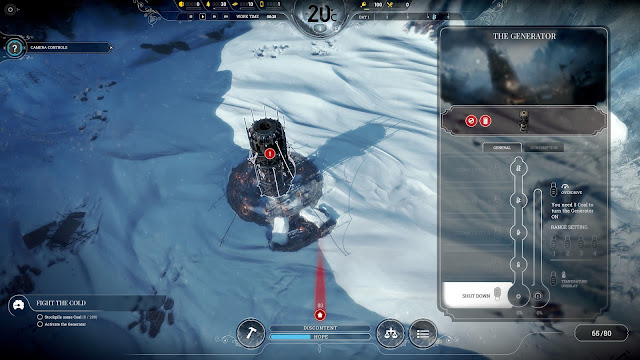Huddled together in a
crater, they gather around their last hope against the cold–an aging steam
generator. Fueled by coal, it can kick out just enough heat to give the last bastion
of humanity a faint glimmer of hope. A moment like this illustrates the essence
of Frostpunk, a survival-style city-builder where you must lead a lonely band
of survivors not against encroaching armies, but against a frigid storm that’s
wiped out most of the human race.
As temperatures plunge
well below freezing, it’s your job to guide the remaining populace towards
establishing a successful, self-sufficient camp. You’ll need hunters and
hothouses, mines and saw mills. And you have to keep all of these machines
running in temperatures that would make even the hardiest penguins shiver.
The essentials are
pretty simple, though. People need houses and jobs. Because this is a survival
situation, everyone works on a near-constant basis. The day starts at 5:00 AM,
and people have a few hours to finish any construction projects before they
head to their primary job for 12 hours. Then they head back home, finish a fewsmall tasks, and go to bed.
This cycle is hugely
important because you’ll need to always make sure you have enough fuel to keep
the generator running through the night. A major part of this is planning out
when and where people need to be to complete their tasks. If you survive,
you’ll build outwards in concentric rings, ensuring that, as you expand, your
core can keep up with the heating demands and provide enough warmth for your
citizens to combat the pervasive chill.
This all works
seamlessly, too. There’s a natural pattern to it all, and you’ll be given
little challenges throughout the day to help give you a bit more structure.
Often, these are emergent consequences of past decisions. If you were able to
keep people alive through the night, but not warm enough, then they could get
sick–posing a new set of challenges to prioritize for the day after. If any one
element of the city is neglected a bit too long, then you’ll start getting more
strident demands from your people, which often become more intricate,
two-to-three-day goals. The structure for it all is elegant and precise–you
always have just enough work, and you’re never left without near and
moderate-term goals to help give you direction.
Your mission is also
strained by all manner of unavoidable disasters. Everything from sudden cold
snaps and necessary amputations to mining disasters and refugee crises crop up,
requiring your intervention. This forms what could be called the crux of the
game–balancing hope and discontent. Compassionate actions give your people
hope. They remind the huddled masses that we (in the general sense) haven’t lost
touch with humanity. Dispassionate or draconian acts, however, drain the
collective will. Unlike most moral choices in games, neither are unilaterally
better.
Compassionate actions
are typically better long-term goals for short-term hits. For instance, taking
on gravely injured or terminally ill refugees will help hold your people
together–reminding them that if they are ever left out or lost, they will be
found and cared for. At the same time, medical care in the post-apocalypse is
damned near impossible, and if you don’t have the facilities to care for the
people, you’ll soon end up with a pile of bodies spreading disease throughoutthe colony. Manage to fix up the wounded, though, and you’ll have an
able-bodied workforce embued with the unbreakable spirit of hope.
These are the kinds of
choices Frostpunk lives on, and what separates it from every other comparable
game. Frostpunk gets a lot of mileage from it, too. It’s hard to cling to the
moral high ground–even if you succeed–when you’re reminded of the sacrifices
you’ve made along the way. That gives your decisions weight in a way that
SimCity and many of its ilk simply can’t. Here, the effects of disasters are
tangible, and the game rightly blames you for your personal failures.
One of your citizens
approaches you: “Children should be put to work. We’re all in this together,
and we need help right now.” Then, you’re shuffled over to a rough-hewn book of
laws for your band. There you can, with a click, start putting the kids to
work. Or you could build child shelters to house the kids and keep them healthyand safe from the cold. The citizens didn’t present you with that second
option–and why would they, they can only see what’s immediately in front of
them?
Frostpunk
itself, in the tutorial, notes that the people you serve are always looking for
a solution, but not necessarily the best one. What’s ultimately best depends on
the emergent challenges you face. Do you have a mysterious illness spreading
wildly through the camp? Are you struggling to find coal, forcing you to char
firewood and construction materials to keep the generator going? These
questions are constant and agonizing throughout. Frostpunk drips cynicism and
bleakness. And yet it is that hopelessness, that fundamental need of human
beings to persist in spite of everything that Frostpunk seeks to embody most.
You become the bulwark against fear–even as you look across the land and
internalize just how hard this fight will be.
That’s powerful
precisely because it hurts. Every time you make a tough call, doubts linger. If
you had been better, if you had chosen differently, maybe you’d have been able
to save everyone. Adding to the distress, Frostpunk’s Hope meter shows you the
consequences of your decisions right as they happen. Send children into the
mines and you can watch the camp’s faith evaporate as a whole chunk of meter
gets lopped off.
This system–balancing
the will of the people against their own needs–works so well precisely because
every mechanism in the game is built to support that core idea. Your job is to
manage the emotional fortitude of the people as much as it is about anything
else. In time, you’ll be able to form scouting parties, outposts, and build a
sprawling network of makeshift towns and settlements that stand together. But again,
that arc intersects with countless brutal decisions. Should you send a scout to
help survivors fight off bears? What about risk turning off an electrical
super-weapon that fries everything it touches–but with the potential of a new
safe haven from the world outside? The story of your civilization, of your
masses hoping, is forged in the choices you make along the way. And they become
a part of the narrative you build.
Frostpunk
is among the best overall takes on the survival city builder to date. Its theming
and consistency create a powerful narrative through line that binds your
actions around the struggle to hold onto humanity in uncertain times. Hope is a
qualified good, but you may not always be strong enough (or clever enough) to
shelter that flame from the cold.









No comments:
Post a Comment